

|
Back to |
| The Front Page |
| News & Features |

|
Man with a mission: Croquet for all |
|||||||
|
by Bill Martin Posted August 12, 2002
|
|
||||||
Bill Martin, U.S. Seniors champion for three consecutive years, is the ultimate fan, aficionado and ambassador for croquet. He is a man with a mission and a method. The mission is to make croquet more popular. The method is to use Golf Croquet as a promotional and teaching tool. In his native Tennessee, he has learned how to teach in just a few minutes anyone - including the local politicians and park and recreation officials - to play and enjoy Golf Croquet. His new website, www.Croquetforall, is dedicated to promoting the Sport of Croquet in all its forms. Martin makes his expertise available to clubs, municipalities, other organizations and individuals as a consultant in the construction, maintenance and management of courts, tournaments, clinics and other events. Why? Because he had a dream. This is his story, in his own words.
A longtime friend and business associate of mine, Jay Martin, had purchased a beautiful house on 5 ˝ acres in Germantown, Tennessee, directly across the road from the proposed Johnson Road Park (more about that later). In the summer of 1992, during the time I was sharing the house and managing the property, Jay asked me to transform a portion of the side yard into a 9-wicket croquet court.
As this idea unfolded, Jay recalled fond childhood memories of his father and uncles playing serious backyard croquet. Little did I know that this recollection would evolve into recruiting a cabinetmaker to custom-make six of the most beautiful mallets I've ever seen. They were first class.
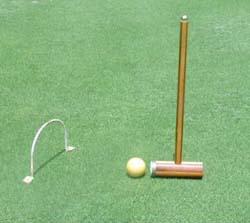
|
| Bill and Jay's handmade equipment |
Granted, acquiring this equipment was significant; however, the next move was paramount in pulling everything together. Jay introduced me to his friend Larry Shore, the maintenance supervisor at the Germantown Country Club. He soon became my friend. As a result of Larry's tutoring, I embarked on a constant regime of poisoning weeds, fertilizing, watering, aerating, top-dressing, and mowing like I'd never been exposed to before. The word "REPETITION" took on a whole new meaning for me. Before the end of the summer, I dare say, we had the most beautiful 9-wicket croquet court in the world. Boy, was I proud!
The importance of winning the war
Obviously we didn't wait until the court reached maturity before we started playing croquet. As soon as all the equipment was at hand we set up the court, and the first battle of many was underway. I knew Jay was competitive because of his background in sports. How competitive was he? This man hated to lose so much that he actually refused to lose. Jay played the way he remembered his dad playing, with one hand and from the side. He was a deft putter in golf, and his touch with the mallet was nothing short of spectacular. To say he was vicious on the court would be a gross understatement. Those who know me know that I'm pretty darned competitive myself; so, needless to say, the battles turned into large-scale WAR!
Manicuring the croquet court was a labor of love for me; however, my desire to beat Jay Martin exceeded anything I had ever tried to accomplish. I tried hard, very hard, and I failed. It was a rare occasion indeed for me to eke out a victory. Jay was a tenacious competitor and relentless with provocative gamesmanship. I became very frustrated - but even more determined. There was no deadness board to tell me which balls I could roquet; there were no clips to mark the next wicket each ball was bound for. My bad memory was my biggest downfall. He had just about convinced me that I had none! I feel compelled to explain that the guidelines we used were the old house rules he remembered from childhood. It seemed that all the rulings favored him. There was no question in my mind that this guy had selective memory. Jay was winning the war....UNTIL....!
Tools of the trade
One day, an article in the local newspaper about croquet reprinted from the Memphis Commercial Appeal jumped out at me. It featured Gene Pearson and his wife Louise Mercuro, relating an experience they had at Pinehurst, North Carolina. They had already made the transition from backyard croquet to USCA six-wicket croquet, and had just returned from their first tournament, the USCA South Regional at Pinehurst. Three items in this article propelled my croquet career enormously: (1) Deadness Board, (2) Wicket Clips, and (3) the official rule book. Wow, did this revelation turn things around! The fact that there was a national organization was also made an impression. "USCA" had a good ring to it.
Goodbye, nine-wicket; hello, six
Now it was research time. I learned about Jaques in London. Jaques was the premier croquet equipment supplier in the world. I immediately challenged Jay to pick up a complete set of equipment on his next business trip to Europe. He obliged, and we immediately started playing this new American version of croquet. The WAR was resumed. For some reason, I was remembering deadness much better and, with the new wicket clips, I could do a better job of keeping up with the proper order.
Nevertheless, arguments were frequent and serious. Even though we now had an official rulebook, we still had problems with interpretation. There were calls to croquet pros Mack Penwell, Jerry Stark, and even the founder of the USCA, Jack Osborn, to settle hot disputes. Some of the time we would complete a game under protests. But the tide was beginning to turn in my favor. Jay was very keen with the strategy, but I had superior shot making skills. In my opinion, we would have been a very formidable doubles team. As a matter of fact, in the few matches in which we did compete as partners, we were undefeated.
My first tournament was the 1993 Tennessee State Championships in Nashville. I placed ninth out of a field of about 20 contestants. I was hooked. My next tournament was a USCA regional in St. Petersburg, Florida. Then came the Greenbrier in White Sulfur Springs, West Virginia, where I won second flight doubles for my first croquet championship. By now, the Sport of Croquet had become an obsession with me. I couldn't get enough of it. I averaged at least one tournament a month. There were those who thought that I had gone off the deep end.
Croquet debuts at the Memphis Botanic Garden
Sometime during the summer of 1994, I received a call from another croquet enthusiast, Bill McAfee. He told me that the Memphis Botanic Garden was building a full size croquet court. This was a total windfall for the handful of USCA players who lived in the Memphis area. The Botanic Garden was part of the City of Memphis Parks Department.
Soon a nucleus of players consisting of Gene Pearson, Bill McAfee, Gene Bryan, and myself met with the interim director, Bert Wolfe, to propose a relationship. To our amazement, we discovered that no one had a complete story as to how this beautiful state-of-the-art croquet court came about. More remarkable was the fact that no one had the slightest idea as to the proper maintenance of this beautiful turf. All I knew was that this was the first, and only, regulation croquet court in the entire state of Tennessee, and we wanted to use it. The result of our meeting with Mrs. Wolfe was that we had a place to play croquet as long as we were members of the Garden and would agree to maintain it.
Politics, personalities, and public policies
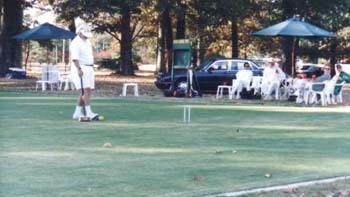
|
| Martin playing on the unimproved court at the Memphis Botanic Gardens. |
We did manage to organize the Audubon Croquet Society as a croquet club, complete with officers. We had two different presidents. Both of them developed personal circumstances that seemed to impair their ability to lead. My title was Vice-President of Maintenance. First and foremost, we needed a well-manicured court to play on, and by golly, we had one. We did manage to have state tournaments under the direction of Gene and Louise.
There was a time when Gene assumed maintenance responsibility of the Croquet Courts. In 1999 we had some vandalism; some teenagers ran some very heavy equipment onto the court, inflicting serious damage. Gene talked to the current interim Director at the time about a co-op arrangement to repair the damage. There was some kind of misunderstanding; consequently this problem was not resolved at the time.
The Johnson Road Park Project
In 1996, when I was playing a lot of tournaments across the country and trying to put everything pertaining to my passion for croquet in proper perspective, I started to think a lot about the question of why this wonderful sport wasn't being pursued by more people. Why was I seeing the same faces at all the tournaments? Why weren't there more young people hitting croquet balls?
First, I took a hard look at my own personal involvement in the sport as it related to promoting growth. The result of this self-evaluation was the realization that I had done very little. Oh sure, I had introduced a couple of protégés, but the bottom line was that I had been quite selfish. As long as I had someone to knock croquet balls around with, I was happy.
Another factor that adversely affected the growth of croquet, in my opinion, was that it was being enjoyed primarily by the privileged, and basically being promoted to that same segment of society. I read and heard about the conflicts around the country the between lawn bowlers and croquet players over the issue of sharing turf. These adversities bothered me.
The challenge of contributing something positive to the sport evolved into a dream and became a sense of mission. When you have a mission, you soon find the means and the methods. I learned that a park was to be built directly across the street from where I lived on Johnson Road. I visited the Germantown Park and Recreation department to gather some information about the specific plans for this park. There I had the good fortune to meet George Brogdon, the Assistant Park Director at that time. George welcomed me into his office and told me that the park plans included two golf putting greens. I actually left my seat with excitement. This thought flew through my mind: They certainly weren't about to stick a couple of putting greens out there without plans to maintain them.
My background in sales prompted me to recognize the opportunity, and I seized the moment. This was no time to be timid. I didn't go so far as to suggest that the putting greens be scrapped in favor of a croquet court, but with all the excitement and enthusiasm I could summon, I explained to George that the turf for a croquet court had to be managed in exactly the same way as a putting green. I also reasoned that there were already many golf courses and putting greens in the area, but no croquet courts.
It goes without saying that the individual who had recommended the putting greens deserves a lot of credit; so I take this moment to pay tribute to an unknown hero, whoever he or she may be. I pray that this little quirk in history didn't shatter someone else's dream. Since I lived across the street from the proposed park, I was very familiar with the enormous dimensions of this property.
As luck would have it, George, too, had some fond memories of playing croquet. In fact, he recalled that at least once during his employment with the City, the employees had played croquet at their annual picnic. This interview was going a little too well. At this point, I expressed my gratitude for giving me some of his time, and after explaining that I had something very exciting to share with him on a later visit, I excused myself. We set an appointment for a follow-up meeting. That meeting ranks very high in my list of all-time great experiences.
The Park and Recreation Department offices were located in The Germantown Center adjacent to the fitness center where I worked out occasionally. It was during my second or third meeting with George that he got the actual plans for the Johnson Road Park and spread them out in front of me. Some of his questions and remarks indicated more than a casual interest. As we visited, we discovered that we shared a common interest. We were both fans of the University of Memphis Basketball Team. I was a season ticket holder, and George was the official who ran the shot clock. I felt great about the friendship; however I was a little anxious because, for some reason, I'd never met the Director, Harvey Faust.
The City of Germantown had just received some very special recognition for having the most progressive Park and Recreation Department (per capita) in the country. I was winning some tournaments and getting more excited about being a citizen of such a progressive community. My foot was in the door, and the iron was hot; so now was as good a time as any to make a very timely visit to City Hall. I called the Mayor's office and asked to speak to The Honorable Sharon Goldsworthy. Mayor Goldsworthy not only received my call, she honored my request for an appointment to discuss my aspirations for The Sport of Croquet. The meeting with the Mayor was very cordial and upbeat. She endorsed the idea of promoting croquet in the community and wished me well.
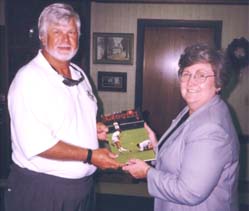
|
| Bill Martin and Mayor Sharon Goldsworthy |
This was all very good and exciting news, but the rest of the story wasn't so great. Although the plans were wonderful, they were long range; there was no money in the budget. The realization of THE DREAM would be several years away at best. I had heard the phrase "on the back burner" before, but it never had such an impact on me previously. I still had not met Harvey Faust.
It gets worse before it gets better
Okay; so it wasn't going to happen immediately.
But it was going to happen - or was it? I had to be patient and remain positive. I would occasionally see George at a ballgame, and we would exchange pleasantries. A year went by and I didn't see George. Then during the next basketball season I saw George at a game, and he asked me if I had heard that he was no longer with the City of Germantown. He was now working with the City of Memphis. My heart sank! After I regained a measure of composure, I asked him what was going to happen with the plans. He assured me that he knew of no reason why they shouldn't go forward. Now, this was bad news to me. I had lost my contact. My biggest link to The Dream was broken. I was sad. Why had I not met Harvey? Did this person really exist? Another year went by. NOTHING! Another year, still NOTHING!
Blindsided by Harvey Faust
One day, out of the blue, Harvey Faust; whom I'd never met or talked to on the phone, called me and asked me point blank if I was still interested in a Croquet Court being built at the Johnson Road Park. My response was " Harvey, this is the best phone call I've ever received"! He explained to me that the money was now in the budget and the City would be letting out bids soon. He further explained that they were going to fill a couple of recreational voids in the community in addition to a Croquet Court, there would be a Nine Hole Disk Golf Course.
This appeared to be another one of those moments to seize the opportunity; so, without hesitation, I asked him if the original plans had called for two putting greens. He said they did. My next question was brass. "How about two Croquet Courts, then?" There was a commitment to consider. The conversation was cordial and very straightforward. Since this initial contact with Harvey, it's been my pleasure to get to know him as a friend. He has honored every single request I've made and more. Not only have they built two full size croquet courts, but also a beautiful pavilion, complete with bathrooms, is currently being constructed between the two courts. I also learned that even though Harvey appears to operate behind the scenes, he gets the job done. Harvey really does exist, and he is very much in charge!
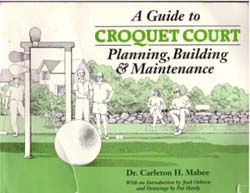
|
Back to the garden
There had been far too much time, hard work, and money invested in this croquet venue to just watch it go by the wayside. Something positive needed to take place immediately. I decided to bite the bullet and "take the bull by the horns", so to speak.
I made an appointment to meet with Ronnie Miller, the Interim Director at that time. My objective was quite simply to bury the hatchet and move forward. What I learned at the outset of this meeting was quite shocking to me. According to Ronnie, the Garden staff had made a decision to spruce up the croquet court by planting Joplin Hollies around the entire boundary. This effort was to take place in the fall of 2000. The project was scrapped, however, when some "maniac", claiming to be a representative of the Croquet Crew, told a Garden staff member that they didn't know what they were doing, and that we had our own ideas as to how that area was to be landscaped. Since the Hollies had already been purchased and delivered, a decision was made to plant as many as possible in other areas of the Garden. Some of the plants, which never made it into the ground, were lost to a winter freeze.
I told Mr. Miller that I was very saddened to learn that anyone representing the interests of croquet would be that narrow-minded. I further explained that I was very determined to overcome all the negatives that interfered with our relationship. I expressed a desire to meet with the Director of Horticulture, Rick Pudwell, to discuss an effort to overcome the Joplin Holly dilemma. Mr. Miller informed me that the new agronomist, Tim Sykes, had some serious reservations regarding the future of the Croquet Court. They had actually had some discussion pertaining to converting it to a different use altogether. I made a strong request to be given a chance to meet with all interested parties to have dialogue regarding the future of this beautiful piece of turf. The only good bit of information I could take from this meeting was that a new director was about to be named. It was recommended that everything be put on hold until this person was in place. On top of all the negatives was the fact that there was no money available for any maintenance.
It was springtime, and the croquet court was in dire need of restoration. I made a commitment to Ronnie Miller, Rick Pudwell and Tim Sykes that I would be responsible for restoring the croquet court. Since this was going to be at my expense and they had nothing to lose, they agreed. This was a considerable gamble, especially in light of past differences and the uncertainty of what the future held. Speaking of gambling, it so happened that I had a good night at the casino a short time thereafter, which enabled me to purchase the Joplin Hollies to border the court. Rick Pudwell and Tim Sykes took care of the planting. This endeavor turned out to be a tremendous wound healer, not to mention what it did to give the croquet court definition and beauty.
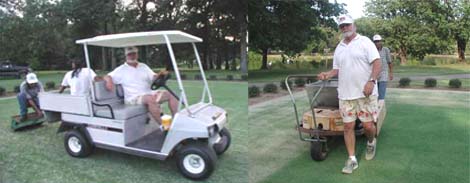
|
| Martin aerates and top dresses the Botanic Garden croquet court. |
Under the tutelage of Tim Sykes, who had worked as a maintenance supervisor at a country club in Florida, I rolled up my sleeves and got busy restoring the croquet court and building a working relationship. I hired so many Spanish-speaking people and worked alongside them for so many hours that I almost learned to speak a new language. Many hours were spent repairing the damage caused by the vandals. I was able to coax my protégé and friend, Will Stephens, to come after he got off work and help out occasionally. The croquet court is bouncing back, and the new Director is now in place.
A new director and a new direction
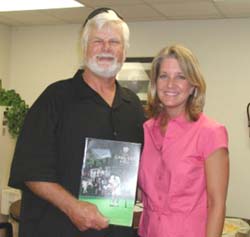
|
| Martin with the Marilyn Ligon, director of the Botanic Gardens. |
To say there was a lot of weeding at the Garden might be a little too much of a pun. But I can say that it seemed like overnight there was a whole new staff. The truth is that it really wasn't new people, but new personalities, great attitudes, fresh new outlooks and most noticeably, an elevated morale. It seemed like another opportunity to seize the moment. I encouraged Marilyn to join me on a visit to the croquet court.
She obviously had toured the acreage of the Garden; however, the beautiful greensward had not been pointed out to her. She was impressed with this professionally manicured piece of turf. This occasion presented to me the chance to emphasize the potential for raising funds for the Garden and, equally important to me, resources for court maintenance. The iron was hot again; so I struck once more. I proposed that we have a "get acquainted social" with the staff during an extended lunch break one day. I suggested Golf Croquet for the mixer.
Marilyn Ligon shared my enthusiasm that day, and sent me a card expressing her excitement for the proposed Golf Croquet outing. I ask Gene Pearson to join me for some critical meetings with Marilyn and members of her staff. Gene, with his expertise in planning, has been a key player. He heads up the Department of City and Regional Planning at the University of Memphis. He is also an integral part of croquet in this area, serving currently as the Tennessee District President for the United States Croquet Association.
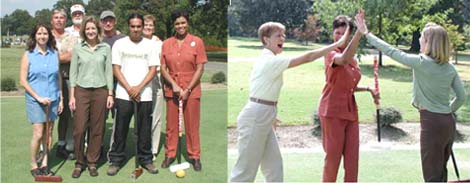
|
| The Bonanic Gardens staff Golf Croquet outing. |
During the luncheon meeting prior to the Golf Croquet games, I proposed a marriage between the Garden Staff and the Croquet Enthusiast. I challenged them to come out on the court, get a mallet in their hand, and have some fun. Thank God for Golf Croquet! I believe we became family that day.
That was 2001. 2002 promises to be even better than last. In addition to having a Golf Croquet tournament for members of the staff, we are working together exploring opportunities to host fund-raising events. It would be safe to say that we are now on the same level playing field, and we all have a stake in the game. We're having twice-weekly Golf Croquet events that are well and enthusiastically attended on Tuesdays and Thursday. Each week, more people are showing up to play.
That's history - now is the future
With a little help from my friends, my local dream for croquet courts and players has come true. The future holds the fulfillment of an even greater dream - the introduction of The Sport of Croquet, in all its forms, to all segments of society. I want to share this dream with a lot of people. It will certainly require the efforts of many. We now have a place to start: CROQUETFORALL!
ACKNOWLEDGMENTS
A year and a half ago, I approached Bob Alman, now the Director of Marketing at the National Croquet Center in West Palm Beach, to talk about what was taking place in my neck of the woods. I had heard about some of Bob's contributions toward the growth of croquet in the San Francisco area, so I was eager to pick his brain. I was surprised to learn that years earlier (1993) he was the editor and chief writer of three volumes - "The Monograph Series on Club Building, Organization and Management," published by the Croquet Foundation of America and still available from the USCA. {Editor's note: Some articles from these volumes are available on the USCA Website.)
I immediately purchased all three volumes and took them home to read. These books were very interesting and served to underscore how fortunate we were here at home. We had no interference from lawn bowlers or any other outside distractions. My hat is off to Bob for his devotion to our sport and the contributions he has made on its behalf. Hopefully, many others will be inspired to promote the sport of croquet to all people.
I also want to thank Howard Watson of Comtutors, Inc. for his assistance in putting this document together.